Discovering Eight Palm Tree Types in Dubai
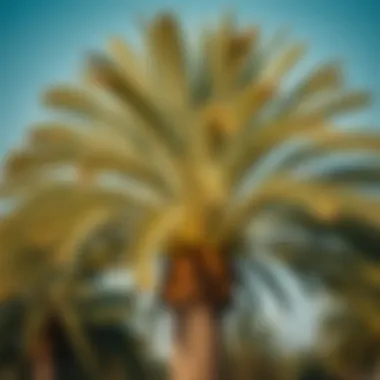
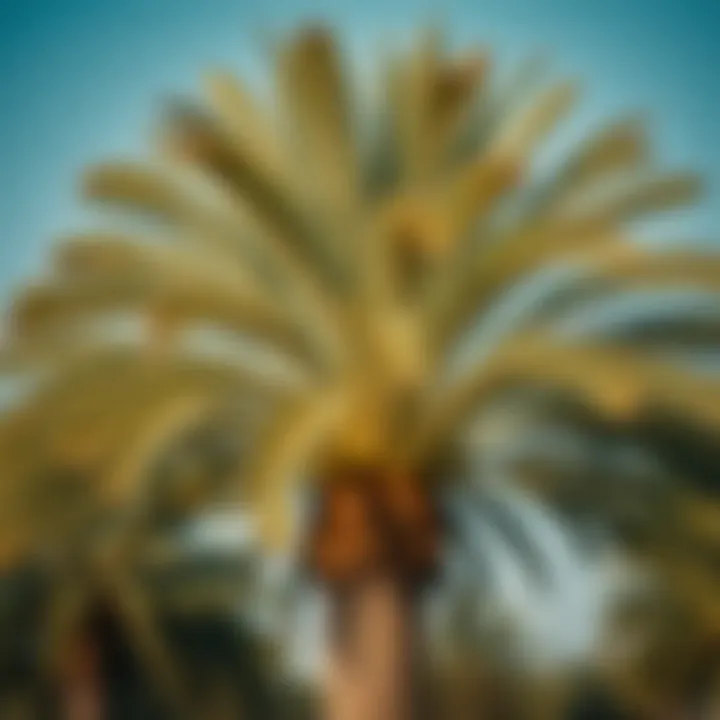
Intro
In the arid and vibrant landscape of Dubai, palm trees stand out as both iconic symbols and practical components of the environment. These towering giants contribute to the grandeur of the city, adding a touch of greenery to otherwise sun-drenched expanses. While many may admire their beauty or seek shade beneath their fronds, there is much more to these palms than meets the eye.
Understanding the types of palm trees that flourish in Dubai is not just a matter of aesthetics but also of functionality. Each species comes with its unique traits—ranging from growth habits to water needs—that can highly influence their suitability in various landscape designs.
In the following sections, we'll take a closer look at eight primary varieties of palm trees often spotted in the region. By examining their characteristics, relevance to real estate, and pricing in the property market, we will provide readers with insights valuable for both residential and commercial ventures.
Whether you are a real estate agent aiming to identify the right greenery to enhance property values or an investor considering landscaping options for new developments, this guide aims to offer a comprehensive rundown of your choices. Let's delve into the fascinating world of palm trees in Dubai.
Foreword to Palm Trees in Dubai
In Dubai, palm trees are more than just a common sight; they are a defining feature of the landscape. Their significance in this vibrant city cannot be overstated. From providing shade in the sweltering heat to acting as a symbol of the region's rich heritage, palms are interwoven into the very fabric of Dubai. For real estate agents, investors, and property managers, understanding the nuances of palm trees is crucial in enhancing property value and landscape aesthetics.
The incorporation of palm trees into Dubai’s urban spaces results from careful consideration of their adaptability to the local climate. With soaring temperatures and minimal rainfall, selecting the right palm species can mean the difference between a thriving outdoor space and a barren plot. These trees not only add beauty but also bring environmental benefits such as improving air quality and reducing urban heat.
The Importance of Palm Trees
Palm trees hold great importance in several aspects of Dubai's environment and economy. They contribute significantly to the local landscape in terms of visual appeal. The tall, slender trunks and lush fronds create an inviting atmosphere that enhances both residential and commercial properties. Moreover, palms are practical; they provide natural cooling, making outdoor living spaces more enjoyable.
Additionally, palms are resilient and require comparatively low maintenance, making them an ideal choice for urban landscaping. They thrive in sandy, arid soils with limited water supply, which is perfect for Dubai's climate.
Beyond their functional benefits, there is an economic aspect to consider. As investors look to enhance property values, incorporating palm trees can serve as a key factor in attracting buyers and renters. Iconic palm-lined streets and gardens often create a sense of luxury and appeal, which can significantly raise property desirability.
Cultural Significance
The cultural significance of palm trees in Dubai spans centuries. These trees are deeply ingrained in the social and historical identity of the region. Traditionally, they have been a source of sustenance, providing dates, which have long been a staple food in Arabian cuisine.
Palms aren’t just flora; they represent resilience and adaptability, qualities that have become synonymous with the people of Dubai. Often found in art, design, and architecture, they evoke a sense of pride among residents and serve as a reminder of the desert's bounty.
Moreover, palm trees have been featured in various local festivities and events, encapsulating the community’s spirit. They symbolize hospitality, often planted in front of homes and businesses to welcome guests. This cultural reverence for palm trees emphasizes their multifaceted role in shaping the identity and experience of living in Dubai.
"Palm trees are not just plants; they are a living testament to Dubai's heritage and resilience in the face of adversity."
In summary, palm trees are pivotal to Dubai's landscape, serving both practical and symbolic purposes. Their ability to thrive in harsh conditions and their cultural significance makes them an enduring aspect of the city’s identity.
Overview of Palm Species
Understanding palm species is vital for anyone involved in Dubai's real estate and landscaping pursuits. The diverse range of palm trees contributes to the city’s visual appeal and ecological function. Different species possess unique characteristics that cater to varying aesthetic needs and growing conditions, making them essential for enhancing both private and public spaces.
Palm trees are more than just decorative elements; they provide shade, contribute to air quality, and can even reduce energy costs by cooling surrounding areas. The choice of the correct palm species can transform a barren landscape into a vibrant oasis, adding value to properties and enriching the urban environment.
Key Characteristics of Palm Trees
Palms are easily recognized for their tall trunks and fan or feather-like fronds. Some key characteristics to note include:
- Trunk Structure: Most palm species have a single, upright trunk that supports the canopy of fronds. However, some, like the Washingtonia, may have multiple trunks depending on growth conditions.
- Leaf Type: Palm leaves can be divided into two main types: palmate (fan-like) and pinnate (feather-like). This distinction affects not only their appearance but also their care requirements.
- Height and Spread: Various species have dramatically different growth rates. For example, Royal Palms can reach up to 66 feet, while the Pygmy Date Palm tops out at a mere 4 to 10 feet.
These factors influence not just the aesthetic outcomes, but also the maintenance and spacing requirements in landscaping. Knowing the right characteristics helps ensure that professionals can select palms suitable for their specific projects.
Growth Habitats
Palm trees thrive in a range of habitats, but their growth significantly depends on climate, soil type, and water availability. Dubai presents a unique environment for these palms:
- Climate Resilience: Dubai's hot and arid climate presents challenges. Species like the Canary Island Date Palm and the Washingtonia Palm are specifically adapted to withstand drought conditions, making them ideal choices.
- Soil Preferences: While many palms prefer sandy or well-drained soils, others may tolerate more loamy compositions. For instance, the Bismarck Palm is noted for its adaptability to poor soils but still needs adequate drainage for optimal growth.
- Water Requirements: Most palms have low to moderate water needs once established. Yet, the Cabbage Palm could be considered when excess water is available, as it can tolerate wetter sites than typical desert palms.
The understanding of growth habitats not only aids in planting but also ensures that palms flourish in their designated spaces, contributing to the overall health and beauty of landscapes in Dubai.
Date Palm
The Date Palm holds a revered place in the hearts and landscapes of Dubai. Its rich history and deep cultural roots make it more than just a plant; it’s a symbol of prosperity and survival in the harsh conditions of the desert. Often seen clustered in rows, the Date Palm not only contributes to the aesthetics of the region but serves as a vital resource for the community.
Description and Features
The Date Palm, scientifically known as Phoenix dactylifera, is an iconic staple in arid climates like that of Dubai. These trees can grow up to 75 feet tall, sporting a stout trunk that can reach more than a foot in thickness. Its leaves are long and feathery, cascading from the top like a giant green fan, creating shade that is much appreciated in the blistering heat.
What’s remarkable about the Date Palm is its incredible adaptability. These trees thrive in sandy soils and can withstand periods of drought, making them perfect for the emirate’s climate. Moreover, their ability to bear fruit, the delicious dates, adds to their usefulness. Dates come in various varieties, some sweet and soft, while others are firmer and more fibrous. What’s even more interesting is how the tree is pollinated; it requires both male and female trees, presenting a unique aspect of its life cycle. This species also exhibits a striking silhouette against the sunset, often found standing tall beside luxury developments or sprawling markets.
Culinary and Economic Value
The benefits of the Date Palm extend far beyond its physical presence in the landscape. Economically, it is a powerhouse. Dates have been a staple food in the Middle East for millennia, providing sustenance with their high nutritional value including fiber, vitamins, and minerals. They are not just tasty snacks but are also the foundation of many traditional dishes. In Dubai, one can find date sweets in abundance, often stuffed or coated with chocolate, adding a luxurious twist to this ancient fruit.
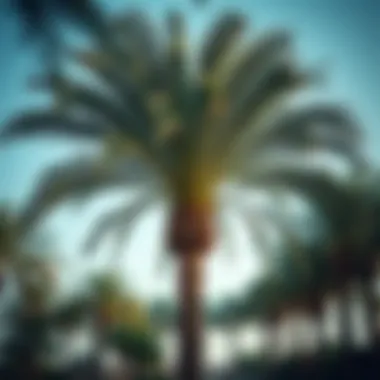
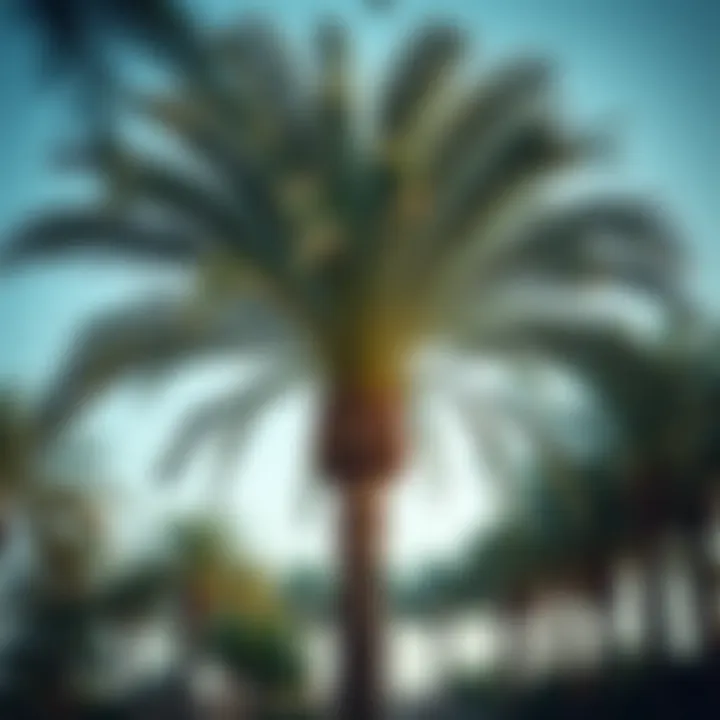
The economic aspect of Date Palms cannot be overlooked. They offer substantial revenues through exports. Countries invest heavily in their cultivation, ensuring a market for both local consumption and international trade. The harvesting season draws many laborers, creating job opportunities and stimulating the economy. With Dubai's growing focus on eco-tourism and promoting local produce, the Date Palm has found itself at the heart of sustainability efforts.
"In Dubai, where tradition meets modernity, the Date Palm stands as a testament to resilience and economic prosperity."
Canary Island Date Palm
The Canary Island Date Palm has carved out a significant niche within the horticultural tapestry of Dubai. Known for its stunning appearance and resilience to harsh conditions, this palm is not just a decorative element; it plays a vital role in enhancing the aesthetic and functional aspects of both residential and commercial landscapes. Its towering stature and striking fronds bring a touch of paradise to the desert environment, making it a preferred choice among property developers and homeowners alike.
Identification and Uses
The Canary Island Date Palm, scientifically known as Phoenix canariensis, is easily recognized by its thick, robust trunk that can grow up to 20-25 meters in height. The trunk is adorned with tightly packed, arching fronds that can stretch up to 4-5 meters wide. Its leaves are pinnate, with a distinct grey-green coloration, offering a bold contrast against the backdrop of the arid desert. This palm can raise eyebrows with its exceptional ability to withstand heat and drought, which is particularly important in Dubai's climate.
In landscapes, it is often chosen for its versatility; it thrives in various soil types and can flourish in both sandy and loamy environments. Its adaptability ensures it can be used in urban settings, parks, and even private gardens, providing shade and visual interest. Additionally, it produces small, date-like fruits that, while not commercially valuable, add a unique touch to the palm’s profile.
Landscaping Applications
Integrating the Canary Island Date Palm into landscape designs can significantly boost the overall aesthetic appeal of a property. Here are some key ways it shines in landscaping:
- Focal Point Feature: Due to its imposing height and lush foliage, it serves as an eye-catching focal point in gardens, courtyards, and along driveways. Its grand presence can elevate the perceived value of any property.
- Shade Provider: The extensive fronds not only beautify spaces but also provide much-needed shade during the sweltering summer months. This makes it ideal for outdoor seating areas and poolsides, allowing for leisure times even in the most extreme heat.
- Eco-Friendly Choice: The palm is relatively low maintenance and requires less water than many other landscaping plants. By investing in these palms, property owners can reduce their environmental footprint while still achieving a lush, tropical look.
- Versatile Pairings: It pairs well with other desert flora, such as succulents and ornamental grasses, creating a harmonious desert landscape. When grouped with lavenders, agaves, or even vibrant bougainvilleas, the result is nothing short of breathtaking.
In summary, the Canary Island Date Palm holds considerable importance as a landscape choice in Dubai, combining beauty, hardiness, and versatility to meet the demands of both nature and human design.
Royal Palm
Royal Palms, scientifically known as Roystonea regia, hold a special place in the tapestry of Dubai's landscaping. Their graceful, towering presence adds a dramatic touch to any space they inhabit. This palm is not just about beauty; it symbolizes elegance and grandeur, making it a favored choice for upscale properties and public spaces alike.
Visual Appeal and Growth Pattern
The Royal Palm is distinguished by its smooth, columnar trunk and lush, feathery fronds that create an impression of majesty. Standing tall, these palms can reach heights of 50 to 70 feet, showcasing a crown of gracefully arching leaves that can span up to 10 feet. This striking silhouette is particularly captivating against the backdrop of the Dubai skyline, where they often frame luxurious developments.
Their growth pattern is quite unique. Typically, Royal Palms grow in an erect manner, displaying a slight natural curve in the trunk. This attribute enhances their aesthetic appeal, giving off a naturally artistic vibe. As they mature, the lower leaves die off, leading to a clean, groomed appearance. This characteristic means less maintenance for property owners, as the palms don’t typically shed messy fronds frequently.
Care and Maintenance
Caring for Royal Palms is relatively straightforward, making them an attractive option for those in Dubai’s bustling urban environment. Despite their tropical origins, they adapt well to the local climate, which often sees extremes of heat and humidity. Here are some critical considerations for their care:
- Watering: Newly planted Royal Palms require regular watering to establish their roots. Once settled, they are quite drought-tolerant. Typically, a deep watering every few weeks in the hotter months will suffice.
- Fertilization: Use a balanced fertilizer during the growing season to promote healthy growth. An application two to three times a year can work wonders.
- Pest Control: Although resilient, keep an eye out for pests like scale insects or palm leaf skeletonizers. Regular inspections can help mitigate any potential infestations.
- Pruning: Minimal pruning is needed, mainly to remove dead fronds. However, trimming should be done carefully, as cutting too much can stress the tree.
"The Royal Palm's combination of elegance and ease of maintenance makes it a standout choice for Dubai's landscape architects."
In terms of property value, installing Royal Palms can elevate the aesthetic allure of a residential or commercial space, ideally appealing to those seeking a luxurious environment. The sight of a well-maintained Royal Palm can evoke feelings of tranquility and opulence, resonating strongly with potential buyers and visitors. In a place like Dubai, where competition is stiff, investing in these palms can distinctly enhance the appeal of any property.
Washingtonia Palm
The Washingtonia Palm holds a notable place in the tapestry of Dubai's evolving skyline. Known for its impressive stature and tropical elegance, this species significantly contributes to the aesthetic appeal of urban spaces. With its high tolerance for Dubai's extreme heat, the Washingtonia Palm becomes not just a beautifying element but serves practical purposes in landscaping. Understanding its characteristics is essential for anyone involved in property management or real estate in the region, as it can be a deciding factor for buyers and tenants who appreciate the blend of functionality and style.
Characteristics and Hardiness
Washingtonia Palms are a treat for the eyes, boasting tall, slender trunks topped with large, fan-shaped leaves that can reach lengths of nearly five feet. One remarkable feature is its resilience. These palms can withstand drought conditions, making them suitable for Dubai’s arid climate. Perhaps one of the more intriguing aspects of the Washingtonia is its growth pattern; they have a natural inclination to form multiple trunks, giving them a unique look that differentiates them from other palms.
- Height: They can grow up to 20 to 30 feet tall, providing a prominent landscape feature.
- Leaf Characteristics: The palmate leaves are deeply lobed, which not only contribute to its iconic silhouette but also assist in providing shade, making the palm a practical choice for outdoor spaces.
- Pest and Disease Resistance: These palms have a strong defense against pests and diseases, minimizing maintenance efforts which is a key consideration for property managers.
"The Washingtonia Palm serves as a symbol of resilience, thriving in conditions that might challenge lesser species."
Usage in Urban Environments
In the urban environments of Dubai, the Washingtonia Palm finds itself right at home. As architects and property developers seek to establish green spaces that enhance the quality of life, this palm plays a crucial role. Its towering height provides excellent shade, making outdoor areas more livable during the scorching summer months. Homeowners and developers appreciate the following:
- Versatility in Landscaping: Washingtonia Palms work well in parks, along roadsides, and in private gardens, adding a touch of the exotic to any landscape design.
- Cohesive Design Opportunities: They can be integrated seamlessly with other plant species, creating harmonious compositions that respond to the desired aesthetics of residential or commercial areas.
- Environmental Benefits: Serving as carbon sinks, these palms help improve air quality, contributing positively to the ecological fabric of the urban ecosystem.
In summary, the Washingtonia Palm enriches Dubai's landscapes, offering hardy characteristics that withstand the challenges of desert life while providing a distinctive visual appeal. For real estate agents and prospective homeowners, this palm is a compelling focal point that balances beauty and practicality.
Cabbage Palm
The Cabbage Palm, with its unique characteristics, plays a significant role in enhancing the landscapes of Dubai. Known for its resilience and grace, this palm variety is distinct in both appearance and functionality. As urban spaces continue to grow, the demand for sustainable and visually appealing plants is greater than ever, making the Cabbage Palm an essential subject of this guide.
Adaptability to Conditions
Cabbage Palms, scientifically referred to as Livistona australis, are aptly named for their crown of leaves that resemble the shape of a cabbage head. One of their prime features is their impressive adaptability. Whether it's scorching heat or occasional bouts of cooler weather, these palms hold their ground. They thrive in diverse soil types, from sandy dunes to clay-heavy areas, showcasing a flexibility that many other plants lack.
Moreover, they can tolerate drought conditions remarkably well once established, a necessity for surviving in Dubai's arid climate. For homeowners or builders looking to green their properties without constant upkeep, Cabbage Palms offer a low-maintenance yet visually striking option. Their ability to withstand periods of neglect while still presenting an appealing aesthetic makes them a wise investment.
Role in Property Aesthetics
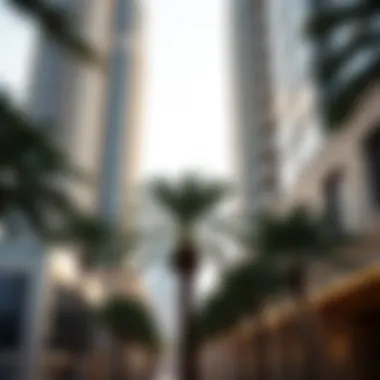
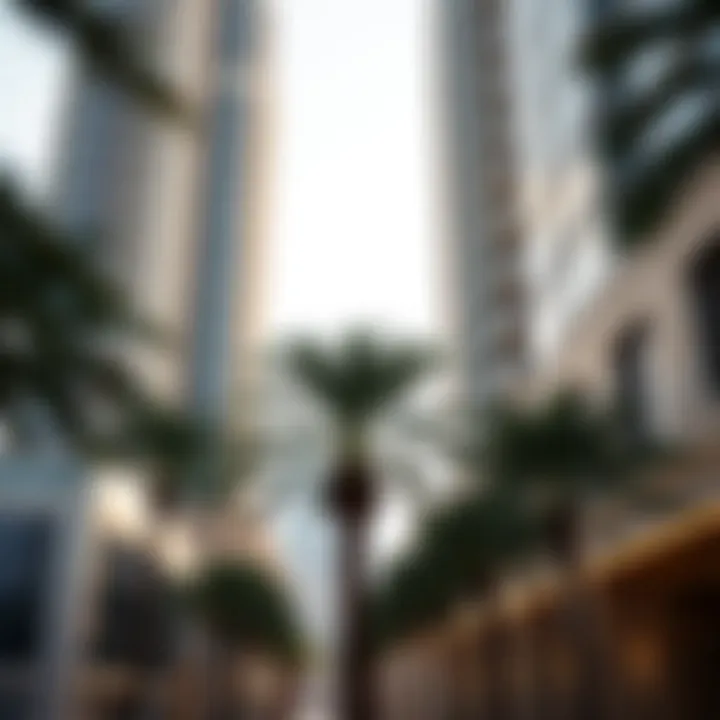
In terms of aesthetics, the Cabbage Palm is nothing short of impressive. Standing tall with a robust trunk and fan-shaped leaves, it adds a dramatic flair to any property. They generally reach heights of about 10 to 20 meters, making them suitable for both residential backyards and commercial landscapes.
Additionally, these palms create a tropical vibe that appeals to property buyers and renters looking for that sought-after exotic feel. The unique structure of the leaves creates interesting shadows and light patterns, contributing to the visual dynamics of a garden or courtyard.
Here are some notable benefits that highlight their importance in property aesthetics:
- Visual Impact: The palm's broad, green leaves create a lush appearance that brings life to otherwise dull spaces.
- Versatility: Suitable for both formal and informal landscaping designs, they can complement a contemporary poolside or a more traditional garden setting.
- Enhancement of Value: Properties featuring well-established Cabbage Palms often have better curb appeal, which could translate to higher market value.
"The Cabbage Palm is not just a tree; it’s a statement of elegance and durability that can enhance the beauty of any property."
Thus, understanding the Cabbage Palm's adaptability and aesthetic qualities is crucial for stakeholders in the Dubai real estate market. By incorporating this palm into landscaping designs, one can create inviting and resilient outdoor spaces that stand the test of time.
Bismarck Palm
The Bismarck Palm stands out as a remarkable specimen in Dubai's diverse landscape, offering both beauty and functionality. This palm is appreciated not just for its aesthetics but also for its robust nature, making it a popular choice in urban developments. With its broad, fan-shaped leaves and striking silvery-blue color, the Bismarck Palm has a majestic presence that graces parks, residential complexes, and commercial spaces alike. It has proven to be a resilient option, adapting well to Dubai's harsh climatic conditions.
Distinctive Appearance
The Bismarck Palm captures attention with its unique silhouette and coloration. The leaves can reach up to 10 feet in diameter and exhibit a beautiful silvery-gray hue that effectively reflects sunlight, adding a cool ambiance to its surroundings. The fronds are usually arranged in a symmetrical fan shape, giving the tree an elegant look.
- This palm can grow up to 40 feet tall, with a stout trunk that widens significantly towards the base.
- Its trunk is marked with ring-like scars from fallen fronds, creating a textured appearance that enhances its character.
In terms of landscaping, its imposing height and unique foliage make it an excellent focal point in gardens or open spaces, often used in bold arrangements to complement surrounding greenery. When grouped with other plants, the Bismarck Palm provides a striking contrast, drawing the eye and enriching the visual landscape.
Uses in Landscaping
Integrating the Bismarck Palm in landscaping schemes offers numerous benefits:
- Shade Provider: The ample canopy provides shade in outdoor areas, making it ideal for parks and public spaces.
- Visual Interest: The distinct color and shape are often used to break the monotony of traditional green landscaping, lending a modern aesthetic to developments.
- Resilience: It withstands drought and other harsh conditions common in Dubai, reducing the need for extensive care and maintenance. This makes it a favored choice for property managers aiming for low-maintenance but visually appealing designs.
In summary, the Bismarck Palm not only serves aesthetic purposes but also fits very practical needs in landscaping. Its unique features and adaptability secure its place among the palm species that significantly enhance Dubai's real estate landscape.
Pygmy Date Palm
The Pygmy Date Palm, also known as Phoenix roebelenii, deserves a spotlight in the palm tree family, particularly in the context of Dubai's landscape. This petite yet striking palm is a dandy choice for those yearning to add a touch of greenery without overwhelming small spaces. Dubai, with its bustling urban environment, often sees property owners and developers seeking efficient landscaping options that do not compromise on aesthetics; this is where the Pygmy Date Palm comes into play.
Small Scale Landscape Solutions
Small scale landscape solutions often call for plants that fit snugly into tight corners and can provide a lush appearance without encroaching into living or working areas. The Pygmy Date Palm shines brightly here because it generally reaches a height of only 4 to 8 feet. Its delicate fronds create a tropical ambiance, perfect for courtyards, balconies, or lined pathways.
Moreover, considering the climate in Dubai, this palm is surprisingly drought-tolerant once established. Property managers and homeowners often note its negligible need for maintenance. By opting for the Pygmy Date Palm, one is not just planting for beauty but also making a smart choice for sustainability in arid conditions.
"The key to maximizing small spaces lies in selecting plants that complement rather than dominate."
Furthermore, due to its compact size, landscapers can cluster multiple Pygmy Date Palms for a visually appealing effect while maintaining functionality. Whether used in residential or commercial settings, these palms can effortlessly enhance a property's charm.
Indoor and Outdoor Applications
What sets the Pygmy Date Palm apart is its versatility, allowing for both indoor and outdoor applications. Bringing this species indoors adds a serene touch to any interior space. The palm filters air effectively and does well in low light, making it an ideal companion for living rooms, offices, or even bathrooms where humidity is beneficial. Room aesthetics elevate with leafy greenery that does not demand the constant attention larger palms might require.
When it comes to outdoor applications, these palms can be quite the scene-stealer. Their resilience means they tolerate wind and salty air, making them suitable for Dubai’s coastal areas. Pairing them with stone features or water fountains can create a tranquil oasis right in one’s backyard. It's not just about greenery; it’s about creating a vibe that resonates with almost any lifestyle.
In essence, the Pygmy Date Palm encapsulates a perfect blend of practicality and beauty. It showcases how thoughtful plant selection can decisively influence the overall appeal of a property. Gardeners and designers alike have embraced this palm not just due to its physical characteristics but also because it embodies an understanding of the local environmental challenges.
Chinese Fan Palm
The Chinese Fan Palm, known scientifically as Livistona chinensis, is not just another palm tree gracing Dubai's landscape; it’s a robust symbol of resilience and adaptability in a region known for its harsh conditions. This palm stands out due to its unique fan-shaped leaves and its versatility, making it an excellent choice for both residential and commercial landscapes. Understanding the growth conditions and design features of this palm can significantly influence property aesthetics.
Growth Conditions and Requirements
The growth requirements of the Chinese Fan Palm are crucial to its thriving in urban environments like Dubai. These palms prefer well-drained soil and can tolerate a variety of soil types, including sandy and clay substrates. Because they originate from subtropical climates, they enjoy warm temperatures, thriving best in ranges between 15°C to 35°C. Although once established, they can handle drought conditions, these palms are better off with regular watering, especially during the scorching summer months.
Some key growth conditions include:
- Sunlight: Chinese Fan Palms flourish in full sun but can also tolerate partial shade.
- Watering: While they have some drought tolerance, consistent moisture helps promote lush, healthy fronds.
- Soil: Well-drained soil prevents root rot, a common ailment in palm trees.
These palms can reach heights of up to 8 meters, creating a stunning effect in any garden or landscape. Their maximum spread can also add to their charm, sometimes extending to 4 to 5 meters. This characteristic makes them ideal for spacious homes or sizable corporate parks in Dubai.
"The Chinese Fan Palm is not just ornamental; it provides essential shade, enhancing outdoor areas and outdoor living spaces."
Design Features in Residential Settings
Incorporating Chinese Fan Palms into residential design is a choice that reflects taste and practicality. Their graceful appearance complements a wide range of architectural styles, from modern homes to more traditional designs. One of the notable attributes is the palm's symmetry, which brings balance to the landscape and makes it visually appealing.

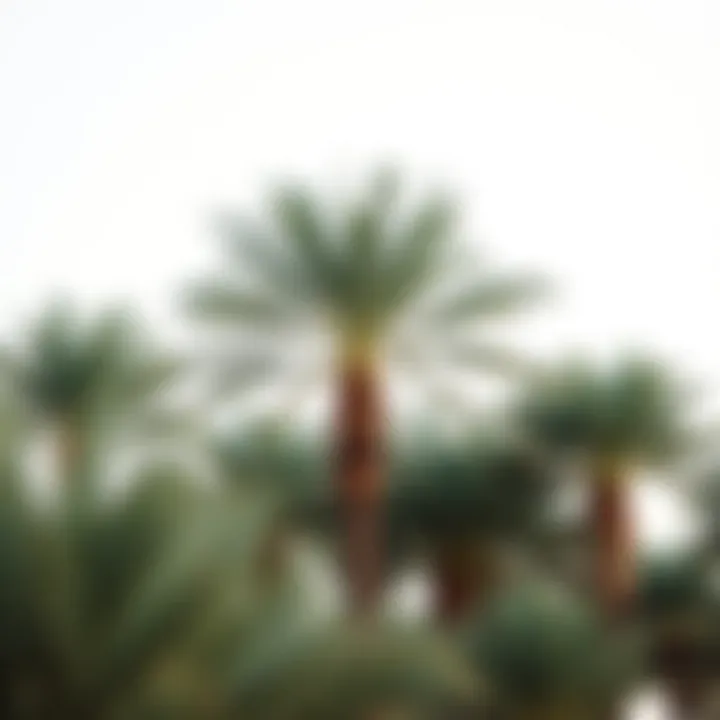
When considering the design aspects:
- Placement: These palms work well as focal points, particularly when planted near entrances or along pathways, guiding guests into welcoming spaces.
- Group Planting: They can be planted in clusters to form a natural privacy screen, providing both aesthetic allure and practical shelter in gardens.
- Integration with Landscaping: The palmate leaves contrast beautifully with other greenery, such as shrubs and flowers, enhancing the overall landscape dynamic.
Additionally, because of their adaptability, they can thrive in pots as well. This characteristic allows homeowners with smaller outdoor spaces to enjoy their beauty. When placed on patios or balconies, they can create a tropical feel even in the heart of the city.
Considerations for Choosing Palms in Dubai
When it comes to selecting the right palm trees for properties in Dubai, a multi-faceted approach is essential. The unique climate and urban environment present challenges and opportunities that must be carefully navigated to ensure the health and aesthetic appeal of these majestic plants.
Understanding Your Environment
Dubai's climate is characterized by extreme heat, low rainfall, and high humidity, particularly in the summer months. Therefore, it becomes paramount to choose species that can withstand these conditions. Not all palms are created equal when dealing with environmental stressors. For instance, the Date Palm is well adapted to arid environments, making it a preferred choice for many property landscapes.
Benefits of Proper Selection
The impact of selecting the appropriate palms can have far-reaching benefits, not just for beauty but for ecological balance, property value, and overall sustainability. By integrating palms that thrive in local conditions, property owners can enjoy:
- Reduced Water Usage: Choosing drought-resistant species helps conserve water, a valuable resource in arid climates.
- Enhanced Property Aesthetics: The right palm trees can elevate the visual appeal of residential and commercial estates, making them more attractive to potential buyers or renters.
- Increased Property Value: Well-maintained, strategically placed palms can significantly boost the market value of a property.
"Selecting the right palms is not just about looks; it’s about aligning plant choice with environmental realities and aesthetics."
Climate Adaptations
Palms must adapt to Dubai's fluctuating climate to thrive. This adaptation involves understanding how specific species interact with temperature changes, light exposure, and soil conditions.
For example, some palms, like the Canary Island Date Palm, can tolerate high sun exposure and can grow to towering heights, making them suitable for larger estates. Conversely, species such as the Pygmy Date Palm are more suited for small gardens or indoor settings as they flourish in lower light and can handle cooler conditions.
Things to consider for climate adaptation:
- Heat Resistance: Look for palms that are known for thriving in sweltering conditions.
- Humidity Tolerance: Some palms prefer drier air; choosing the right species can minimize plant stress.
- Soil Adaptation: Understanding whether the palm prefers sandy, clay, or well-draining soils can significantly affect its growth.
Maintenance Needs
Even the most resilient palm trees require some level of care, which varies across species. Understanding the maintenance needs is key to ensuring longevity and health, especially in a city where conditions can be less than forgiving.
Consider factors like pruning cycles, water requirements, and susceptibility to pests or diseases. For instance, the Washingtonia Palm is relatively low-maintenance once established, but it may need regular pruning to remove dead fronds and enhance its visual appeal.
A few key maintenance considerations include:
- Pruning: Regularly remove dead or damaged fronds to promote healthy growth.
- Watering: While some palms are drought-resistant, newly planted palms will need adequate watering until they establish.
- Fertilization: Understand the nutritional needs of your chosen palms to ensure consistent growth.
In sum, thoughtful selection and awareness of environmental adaptations and maintenance requirements play an integral role in the successful integration of palm trees in Dubai's landscape, enhancing both aesthetic and functional qualities for properties.
Integrating Palm Trees into Property Designs
Integrating palm trees into property designs is not just an aesthetic choice; it's about enhancing the value and appeal of a space. In Dubai, where the landscape is a mix of modern architecture and natural beauty, palm trees play a pivotal role. They offer a bridge between the bustling urban environment and the serene embrace of nature. The choice of palm species can significantly impact the overall vibe of a property, whether it is a residential area, a commercial building, or a luxurious hotel.
Using palms contributes to the visual identity of a property. Imagine walking through a well-designed landscape dotted with swaying palms, casting dappled shadows on pathways. This experience becomes even more significant for places like Dubai, where creating a standout impression is paramount. The right species can create a tropical oasis effect, promoting relaxation and enjoyment while mingling with the sun-drenched city.
Aesthetic Considerations
When considering the aesthetic impact of palm trees, one must focus on the scale, texture, and color offered by different species. For instance, tall varieties such as the Royal Palm can serve as prominent focal points, guiding the eye upwards and creating a sense of grandeur. Meanwhile, shorter palms like the Pygmy Date Palm add depth to layers of greenery without overshadowing other design elements.
The texture of palm fronds also adds a unique touch. The feathery, waving leaves of the Canary Island Date Palm contrast beautifully with the sleek lines of modern architecture, striking a balance between nature and design. Color plays an equally important role, with the blue-green hues of the Bismarck Palm standing out against the warm browns and creams of desert-themed properties. Moreover, the seasonal changes that palms can bring into a landscape—through flowering, fruiting, or leaf shedding—can provide continual visual interest throughout the year.
Planting patterns also contribute to a cohesive design. Groupings of palm trees styled in clusters can emphasize entrances or create calm, shaded areas for water features or sitting spaces. Mixing different species can add variety and intrigue, creating a natural, organic look that enhances the setting.
Functional Aspects
Functionally, palm trees offer much more than just visual enhancement. They can provide crucial shade and shelter, making outdoor spaces more usable and enjoyable. This can be particularly valued in Dubai, where the intense sun often limits the time residents and visitors can spend outdoors. Positioning palms strategically around pools or patios can foster a cooling microclimate, encouraging social gatherings and leisure activities, therefore boosting a property's utility.
Additionally, the presence of palms can improve air quality. As they transpire, palm trees release moisture, subtly helping to regulate temperature and humidity levels within their immediate environment. This can create a more comfortable atmosphere not only for people but also landscapes at large.
Furthermore, integrating palms into property designs can have significant economic benefits. Properties that feature lush, well-designed landscapes often command higher resale values and more significant rental yields. The undeniable allure of palm-dotted vistas draws in potential buyers, renters, and investors alike.
The End: The Value of Palm Trees in Dubai
Palm trees hold a special place in the landscape of Dubai, serving not just an aesthetic function but also contributing significantly to the environment and the economy. Their tall and graceful presence shapes the visual identity of the city, offering greenery in an otherwise arid environment. Moreover, the palms play a vital role in economic activities, particularly tourism and real estate development. As modern Dubai continues to evolve, palm trees remain a steadfast symbol of its heritage and future, connecting past traditions with contemporary lifestyles.
Recap of Key Points
- Aesthetic Appeal: Palm trees are integral to Dubai’s landscape design, adding to the city’s unique charm and allure.
- Environmental Benefits: These trees provide shade, help in cooling the urban environment, and improve air quality by producing oxygen and absorbing carbon dioxide.
- Economic Value: The date palm, in particular, offers both cultural and economic significance, playing a role in local agriculture and culinary practices.
- Cultural Significance: As deeply rooted symbols in Emirati heritage, palm trees reflect the identity and culture of Dubai.
- Diversity of Species: The range of palm types allows extensive landscaping options for various settings, from residential to commercial.
Future of Palm Planting in Urban Spaces
Considering the increasing urbanization of Dubai and the ongoing climate challenges, the future of palm planting seems promising yet requires careful planning. Some essential factors to ponder include:
- Adapting to Climate Change: As temperatures rise, selecting heat-resistant palm varieties will become more crucial. Species that can withstand Dubai’s extreme summer heat while managing limited water resources will be prioritized.
- Sustainable Practices: A movement toward more sustainable landscaping will influence the choice of palm trees. Creating green spaces that utilize natural rainfall and maintaining soil health will be of paramount interest.
- Innovative Urban Design: As urban spaces evolve, integrating palm trees into multifunctional designs—such as parks, walkways, and residential complexes—will enhance livability.
- Community Engagement: Future initiatives might focus on involving communities in planting and nurturing palm trees. This not only educates people but also fosters a sense of ownership over public spaces.
"Palm trees are more than mere trees; they are the beating heart of Dubai's identity, deeply woven into its fabric of life."
By looking forward to future developments, there’s clear potential for palm trees to thrive in Dubai's ever-changing urban landscape, ensuring that these iconic symbols continue to beautify and enhance the environment for generations to come.







